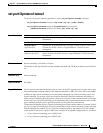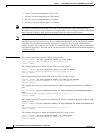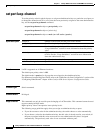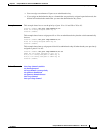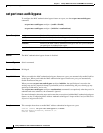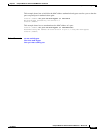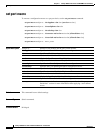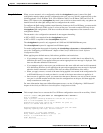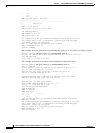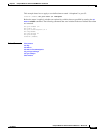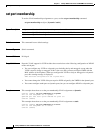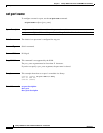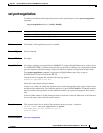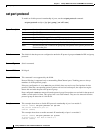
2-599
Catalyst 6500 Series Switch Command Reference—Release 8.6
OL-8977-01
Chapter 2 Catalyst 6500 Series Switch and ROM Monitor Commands
set port macro
Usage Guidelines When you use automatic voice configuration with the ciscoipphone keyword, some of the QoS
configuration requires phone-specific configuration (trust-ext, ext-cos), which is supported only on the
following phones: Cisco IP Phone 7910, Cisco IP Phone 7940, Cisco IP Phone 7960, and Cisco IP
Phone 7935. However, the ciscoipphone keyword is not exclusive to these models only; any phone can
benefit from all the other QoS settings that are configured on the switch.
To configure the QoS settings and the trusted boundary feature on the Cisco IP Phone, you must enable
Cisco Discovery Protocol (CDP) version 2 or later on the port. You need to enable CDP only for the
ciscoipphone QoS configuration; CDP does not affect the other components of the automatic voice
configuration feature.
The automatic voice configuration commands do not support channeling.
A PFC or PFC2 is not required for the ciscoipphone keyword.
A PFC or PFC2 is required for the ciscosoftphone keyword.
The ciscoipphone keyword is only supported on 10/100 and 10/100/1000 Ethernet ports.
The ciscosoftphone keyword is supported on all Ethernet ports.
To see the configuration that results in choosing the ciscodesktop, ciscorouter, or ciscoswitch keyword,
see to the “Configuring a VoIP Network” chapter of the Catalyst 6500 Series Switch Software
Configuration Guide.
When applying user-defined macros, follow these guidelines and restrictions:
• If you attempt to apply a macro on a port and the macro has a variable that is not defined in its
definition, the macro is not applied on the port and an appropriate error message is displayed. This
does not affect the definition of the macro.
• If you attempt to apply a macro on a port and the macro has some valid and some invalid commands
in its definition, the macro is still applied on the port and an appropriate error message is displayed
when the invalid command is executed. This does not affect the definition of the macro.
• When you apply a macro, a record of the macro being applied is not stored in the configuration file
or NVRAM. However, for each port there is a record of the latest macro that was applied to it.
• Once a macro is applied to a port, you cannot clear the macro. However, one way to cancel a macro
on a port is to define another macro that clears the configurations on the port, and then apply the
newly created macro on the port.
For more information about user-defined Smartports macros, see the “Configuring a VoIP Network”
chapter of the Catalyst 6500 Series Switch Software Configuration Guide.
Examples This example shows how to execute the Cisco IP Phone configuration macro with an auxiliary VLAN:
Console> (enable) set port macro 3/1 ciscoipphone vlan 2 auxvlan 3
Port 3/1 enabled.
Layer 2 protocol tunneling disabled for CDP STP VTP on port(s) 3/1.
Port 3/1 vlan assignment set to static.
Spantree port fast start option set to default for ports 3/1.
Port(s) 3/1 channel mode set to off.
Warning:Connecting Layer 2 devices to a fast start port can cause
temporary spanning tree loops. Use with caution.
Spantree port 3/1 fast start enabled.
Dot1q tunnel feature disabled on port(s) 3/1.
Port(s) 3/1 trunk mode set to off.
VLAN Mod/Ports
---- -----------------------



